-
ORIGINAL ARTICLE12-16-2024
Respectful care for postpartum women with sickle cell disease: a netnographic study
Revista Brasileira de Enfermagem. 2024;77(6):e20230545
Abstract
ORIGINAL ARTICLERespectful care for postpartum women with sickle cell disease: a netnographic study
Revista Brasileira de Enfermagem. 2024;77(6):e20230545
DOI 10.1590/0034-7167-2023-0545
Views1See moreABSTRACT
Objectives:
to analyze principles of respectful maternity care in narratives of postpartum women with sickle cell disease, relating them to Sustainable Development Goals.
Methods:
netnographic study, with two videos published in 2020. Deductive iconographic and thematic analysis by Respectful Maternity Care Charter, organized in MAXQDA.
Results:
principles identified were the right to: freedom from harm and ill-treatment; information, informed consent, refusal of medical procedures, and respect for their choices and preferences including companion; be considered a person from birth, with dignified and respectful treatment; health at the highest possible level; newborns being with their parents or guardians. The Sustainable Development Goals for women by 2030 were not positively contemplated in postpartum women’s experience.
Final Considerations:
it is appropriate that health workers qualify themselves to provide respectful maternity care, with qualified listening, understanding, and resolution of unique demands of postpartum women with sickle cell disease, seeking equality in care for women.
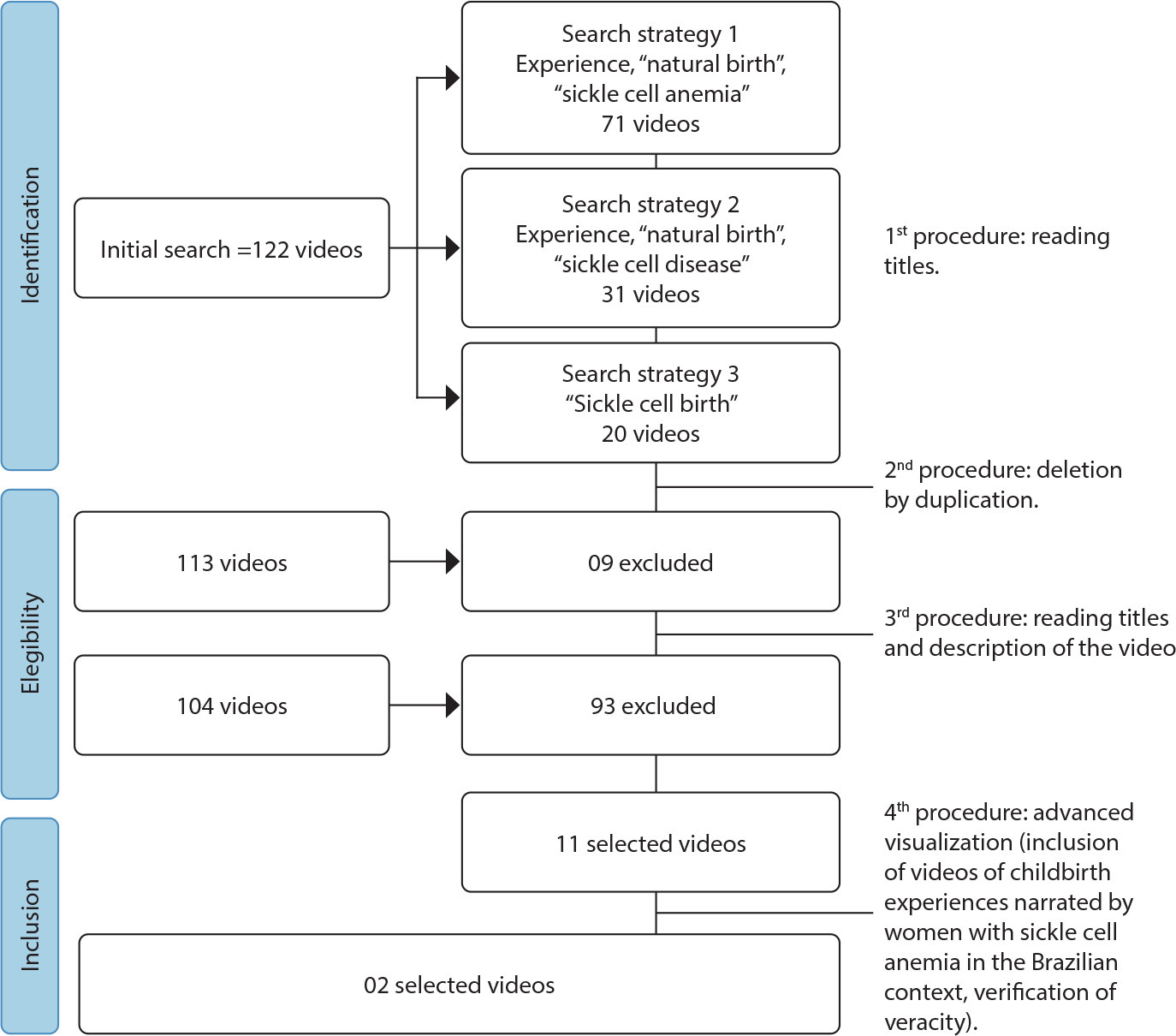
-
12-16-2024
GerenciaDOR™: development of digital technology by nurses for the assessment of patients with chronic pain
Revista Brasileira de Enfermagem. 2024;77(6):e20240050
Abstract
GerenciaDOR™: development of digital technology by nurses for the assessment of patients with chronic pain
Revista Brasileira de Enfermagem. 2024;77(6):e20240050
DOI 10.1590/0034-7167-2024-0050
Views0See moreABSTRACT
Objectives:
to develop a digital technological solution (prototype) for assessing patients with chronic pain.
Methods:
this is a methodological and technological development study based on the Human-Centered Design framework and the principles of Patient-Centered Care. The prototype guides patients through a body diagram and directs them to an evaluation using specific instruments that address the multidimensional aspects of chronic pain.
Results:
the GerenciaDOR* project enables navigation through the Web App screens, providing access to pain assessment features up to the presentation of results.
Final Considerations:
the study describes a systematic approach to pain assessment and expands nurses’ knowledge in pain management. Additionally, it can promote the development of other digital technologies for chronic pain assessment and contribute to a multidisciplinary, patient centered treatment.
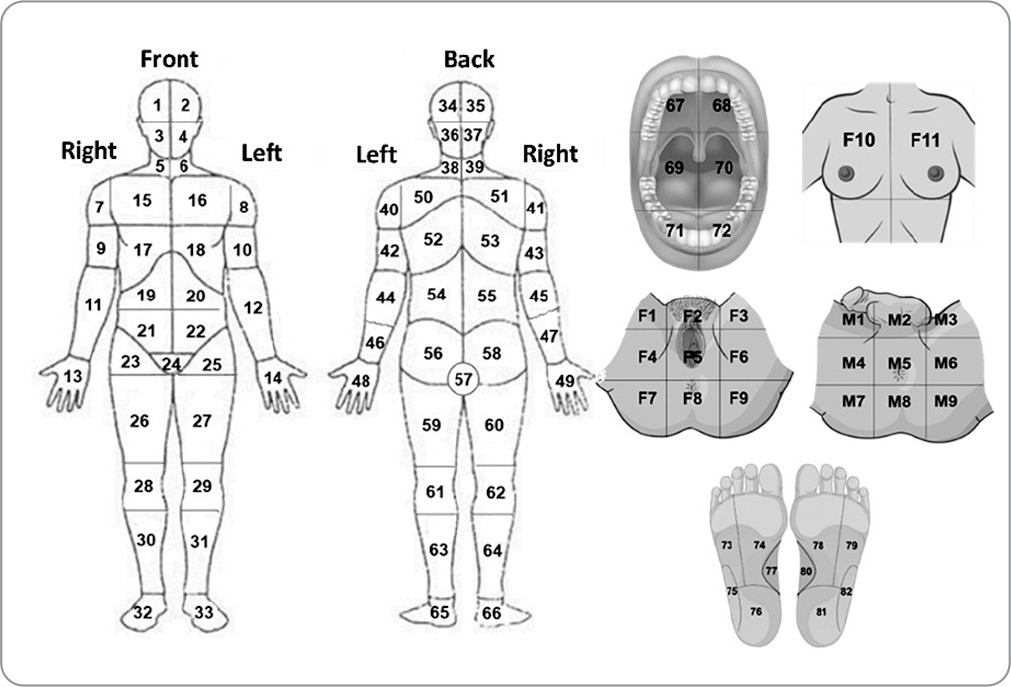
-
ORIGINAL ARTICLE12-16-2024
Psychometric analysis of ProQOL-BR in nursing: building hospital safety and protection
Revista Brasileira de Enfermagem. 2024;77(6):e20240085
Abstract
ORIGINAL ARTICLEPsychometric analysis of ProQOL-BR in nursing: building hospital safety and protection
Revista Brasileira de Enfermagem. 2024;77(6):e20240085
DOI 10.1590/0034-7167-2024-0085
Views0See moreABSTRACT
Objectives:
to analyze the psychometric properties of the ProQOL-BR instrument in hospital nursing professionals.
Methods:
a methodological study to validate the ProQOL-BR. Confirmatory factor analysis, assessment of local and global adjustment quality, Pearson hypothesis testing and Cronbach’s alpha internal consistency analysis were used.
Results:
a total of 490 professionals participated. The model presents adequate quality due to factor weights (λ≥ 0.40), acceptable overall fit quality and adequate chi-square ratio and degrees of freedom (χ2/g.1=2.51) for the parameters of CFI (0.923), GFI (0.902), TLI (0.914) and RMSEA (0.042). In terms of validity, it was shown to be adequate with CC=0.89. The internal consistency obtained by standardized Cronbach’s alpha was 0.761. Criterion validity was shown to be favorable with significant correlations (0.001).
Conclusions:
the instrument was validated regarding content, criteria and reliability. Three questions were removed from the original instrument, ProQOL-BR, leaving the final instrument with 25 questions.
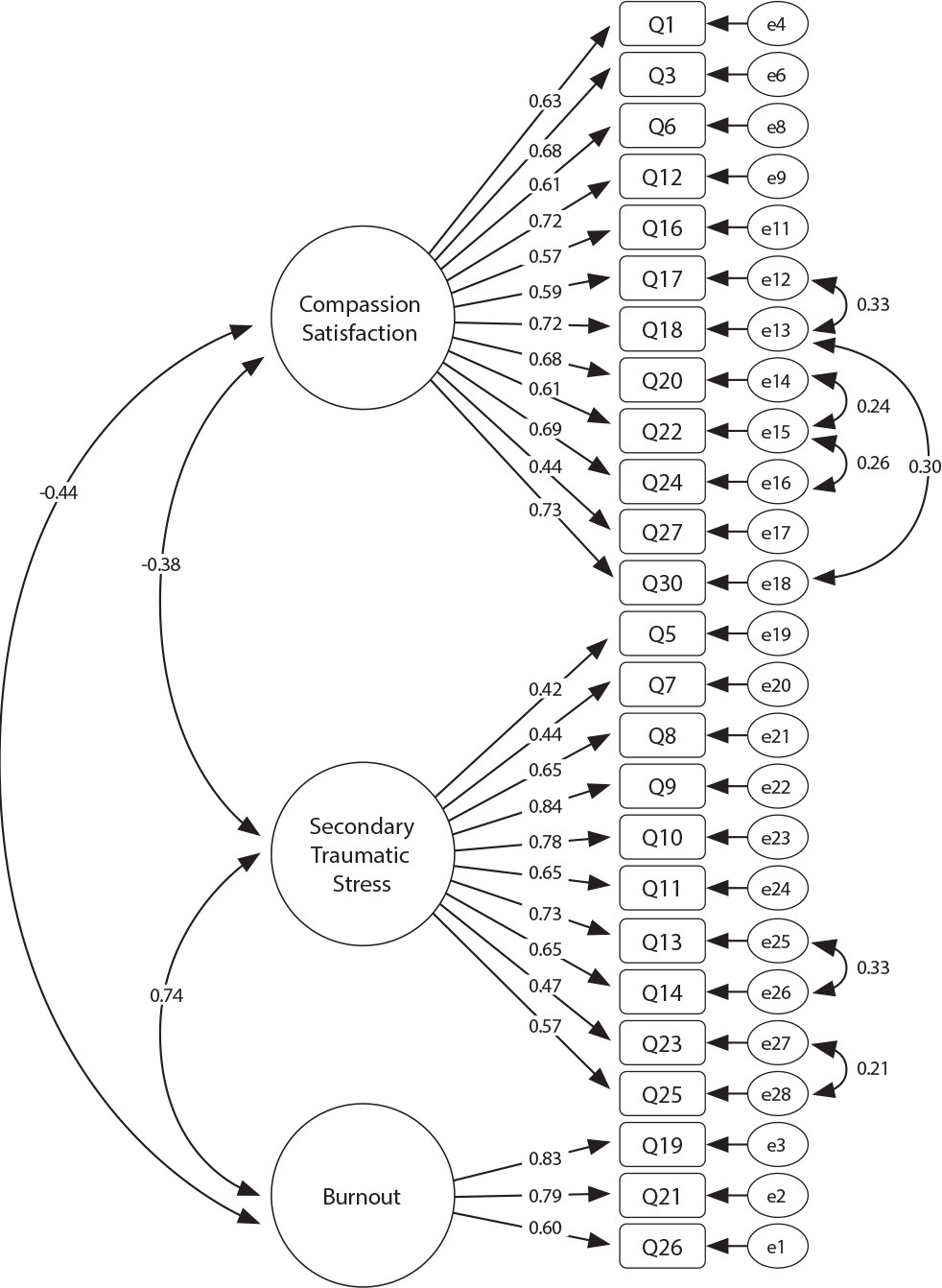
-
REVIEW12-16-2024
Recommendations for guidelines for promoting mental health in the workplace: an umbrella review
Revista Brasileira de Enfermagem. 2024;77(6):e20240086
Abstract
REVIEWRecommendations for guidelines for promoting mental health in the workplace: an umbrella review
Revista Brasileira de Enfermagem. 2024;77(6):e20240086
DOI 10.1590/0034-7167-2024-0086
Views1See moreABSTRACT
Objectives:
to summarize the recommendations of guidelines for promoting mental health in the workplace.
Methods:
an umbrella review, according to Joanna Briggs Institute and Preferred Reporting Items for Systematic reviews and Meta-Analyses methodological assumptions. Data collection was carried out in January 2021 and updated in July 2023 in the American Psychological Association, Cochrane Library, EMBASE, National Library of Medicine, and Scopus databases. Systematic reviews that assessed guidelines with recommendations for mental health care for workers were included. PROSPERO registration CRD42023461845.
Results:
four systematic reviews published between 2015 and 2018 were identified. The abstracts highlighted actions that facilitate and inhibit the recommendations as well as three categories of intervention: primary prevention – worker protection; secondary prevention – promoting workers’ mental health; and tertiary prevention – supporting, monitoring and rehabilitating workers upon returning to work.
Conclusions:
the interventions are based on prevention, promotion and early recognition, support and rehabilitation of mental health problems.
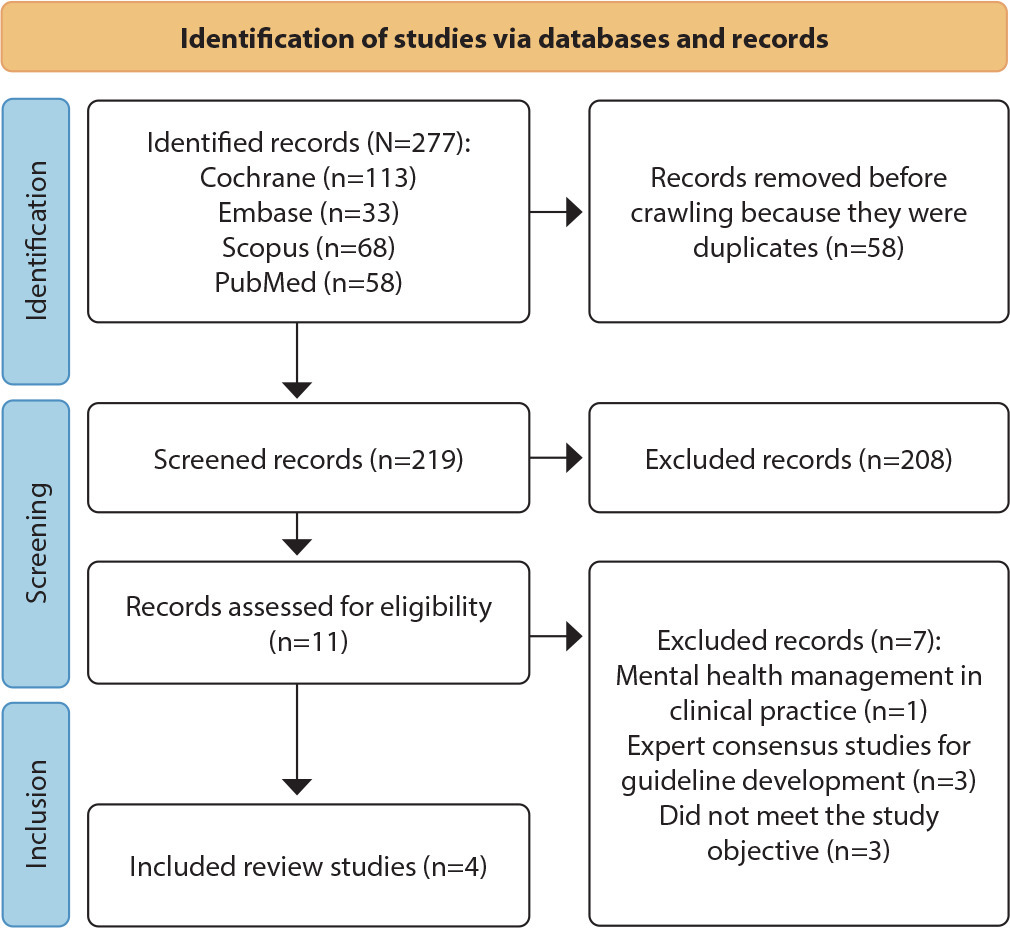
-
ORIGINAL ARTICLE12-16-2024
Analysis of omission of antimicrobial doses in Intensive Care Units
Revista Brasileira de Enfermagem. 2024;77(6):e20240102
Abstract
ORIGINAL ARTICLEAnalysis of omission of antimicrobial doses in Intensive Care Units
Revista Brasileira de Enfermagem. 2024;77(6):e20240102
DOI 10.1590/0034-7167-2024-0102
Views0See moreABSTRACT
Objectives:
to analyze the rate of antimicrobial dose omission in intensive care units.
Methods:
cross-sectional study carried out between March 1 and September 30, 2023, in intensive care units of a University Hospital in Rio de Janeiro.
Results:
the sample consisted of 452 prescriptions and 1467 antimicrobial doses. The dose omission rate was 4.29%. Each antimicrobial prescribed increased the chance of omission by 51%. The strategy of double-checking prescriptions helped prevent 30% of antimicrobial dose omissions (p=0.0001).
Conclusions:
monitoring the omission of antimicrobial doses can guide nursing actions to improve quality and patient safety, contributing to the prevention of medication errors, antimicrobial stewardship and the fight against antimicrobial resistance.
-
ORIGINAL ARTICLE12-16-2024
Health literacy development of Primary Health Care patients: qualitative research
Revista Brasileira de Enfermagem. 2024;77(6):e20240154
Abstract
ORIGINAL ARTICLEHealth literacy development of Primary Health Care patients: qualitative research
Revista Brasileira de Enfermagem. 2024;77(6):e20240154
DOI 10.1590/0034-7167-2024-0154
Views0See moreABSTRACT
Objectives:
to identify the process of health literacy development among primary care patients, relating it to their self-care practices.
Methods:
qualitative, prospective research with 22 patients from two Family Health Strategy units. Data were obtained through individual semi-structured interviews, examined through descriptive statistics and thematic content analysis.
Results:
the results discuss how participants learn about health and how this resonates in their behaviors, culminating in two thematic categories: “Health knowledge construction”; and “Dialogue between health knowledge construction and patient care actions”.
Final Considerations:
health knowledge is developed mainly through interpersonal relationships, mediated by health professionals through bonding and communication. Community educational actions and training of health professionals in communication can promote health literacy and self-care among patients.
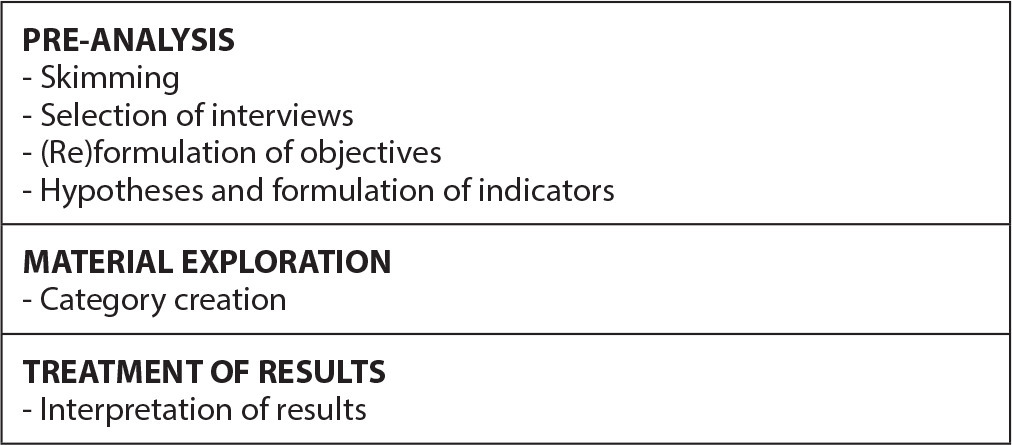
-
ORIGINAL ARTICLE12-16-2024
Bladder ultrasound: evidence of content validity of a checklist for training nurses
Revista Brasileira de Enfermagem. 2024;77(6):e20230183
Abstract
ORIGINAL ARTICLEBladder ultrasound: evidence of content validity of a checklist for training nurses
Revista Brasileira de Enfermagem. 2024;77(6):e20230183
DOI 10.1590/0034-7167-2023-0183
Views0See moreABSTRACT
Objectives:
to develop and analyze evidence of content validity of a checklist for training nurses in measuring bladder volume through ultrasound.
Methods:
a methodological study, consisting of three stages: literature review; instrument item preparation; and analysis of evidence of content validity. The Content Validity Index (CVI) and Gwet’s AC2 were used for content validity analyses.
Results:
the checklist consisted of 23 items. The CVIs for clarity, relevance and dimensionality were 0.99, 0.99 and 0.98 respectively, and the CVIs for Gwet’s AC2 with coefficients for clarity, relevance and dimensionality were 0.89, 0.97 and 0.95, respectively, with p<0.001.
Conclusions:
the checklist developed for training nurses in measuring bladder volume through ultrasound achieved adequate evidence of content validity, and can be used to train nurses in clinical practice and future research.
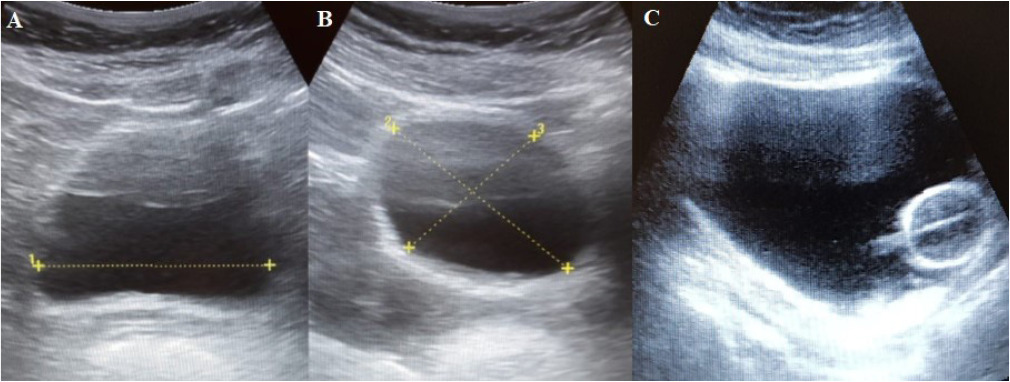
-
12-16-2024
A relação entre gênero, formação educacional e ambiente de aprendizagem com a ansiedade do estudante de enfermagem
Revista Brasileira de Enfermagem. 2024;77(6):e20220615
Abstract
A relação entre gênero, formação educacional e ambiente de aprendizagem com a ansiedade do estudante de enfermagem
Revista Brasileira de Enfermagem. 2024;77(6):e20220615
DOI 10.1590/0034-7167-2022-0615
Views1See moreRESUMEN
Objetivos:
identificar las variables asociadas a la práctica clínica relacionadas con la ansiedad de los estudiantes de enfermería.
Métodos:
se utilizó un diseño descriptivo, cuantitativo, correlacional con las recomendaciones STROBE, EQUATOR. La población fue de 233 estudiantes de enfermería con una muestra de 135 personas. Los datos se recopilaron de marzo a abril de 2022 utilizando instrumentos validados.
Resultados:
la prueba de chi-cuadrado y razón de verosimilitud significativa para género, formación académica y entorno de aprendizaje son superiores a 0.05, por lo que no existe una relación significativa entre las variables y la ansiedad de los estudiantes.
Conclusiones:
los estudiantes necesitan prepararse nuevamente antes de ingresar al campo de la práctica. Investigaciones cualitativas también son necesarias.
-
ORIGINAL ARTICLE06-16-2021
The meaning of nursing 200 years after Nightingale – perceptions of professional practice in the intensivist context
Revista Brasileira de Enfermagem. 2021;74(2):e20200364
Abstract
ORIGINAL ARTICLEThe meaning of nursing 200 years after Nightingale – perceptions of professional practice in the intensivist context
Revista Brasileira de Enfermagem. 2021;74(2):e20200364
DOI 10.1590/0034-7167-2020-0364
Views0See moreABSTRACT
Objectives:
to know the meaning of contemporary nursing from the experience of intensive care nurses.
Methods:
qualitative research based on the theoretical framework of Symbolic Interactionism and the methodological framework of Interpretive Interactionism. The setting was a general hospital in Bahia, being carried out with 12 nurses working in intensive care for at least one year, through semi-structured interviews and drawing-text-theme technique, whose data were organized according to Miles and Huberman and analyzed upon the referential.
Results:
the sense of being a nurse was evidenced; a being for care, resulting from the experience in intensive care, capable of promoting the development of professional self-image, by causing, in nurses, other skills – besides the scientific ones, such as empathy, creativity, spirituality and compassion.
Final Considerations:
the sense of being a nurse, currently, expresses developments inherited from the Nightingalean proposal, but transcends the technical-managerial emphasis of this to a humanistic care perspective converging with our contemporary professional identity: a being for care.
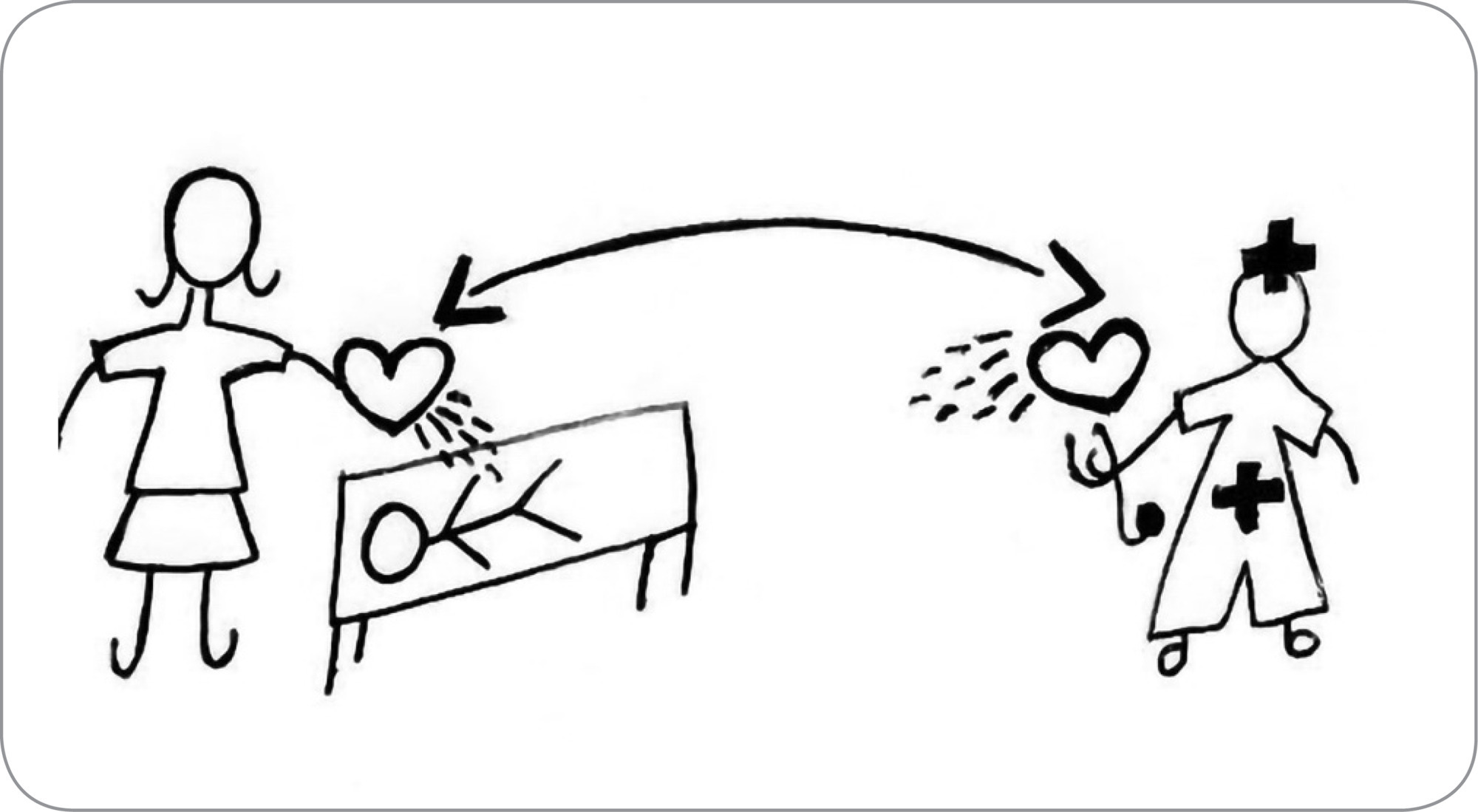
-
ORIGINAL ARTICLE05-28-2021
In(compatibility) of intravenous drugs in critical units: adult cohort
Revista Brasileira de Enfermagem. 2021;74(2):e20200501
Abstract
ORIGINAL ARTICLEIn(compatibility) of intravenous drugs in critical units: adult cohort
Revista Brasileira de Enfermagem. 2021;74(2):e20200501
DOI 10.1590/0034-7167-2020-0501
Views1See moreABSTRACT
Objectives:
To analyze potential (in)compatibilities of intravenous drugs based on the scheduling prepared by the nursing team.
Methods:
historic cohort (retrospective) with 110 adults in critical units. Intravenous medications were identified concomitantly, whose pairs were analyzed for (in) compatibility using the screening system Trissel’s™ 2 Compatibility IV-Micromedex 2.0. Parametric and non-parametric statistic were used according to the nature of the variable.
Results:
565 pairs of drugs were identified. Of these, 44.9% were compatible; and 8.8%, potentially incompatible. Most potentially incompatible pairs involved substances with alkaline pH such as phenytoin (32%) and sodium bicarbonate (8%) and weak acids such as midazolam (12%) and dobutamine (6%), which could result in precipitate formation.
Conclusions:
almost half of the mixtures simultaneously administrated was compatible, which indirectly reflects in the organized work between the nursing team and the clinical pharmaceutic in the discussions and decisions related to time scheduling.
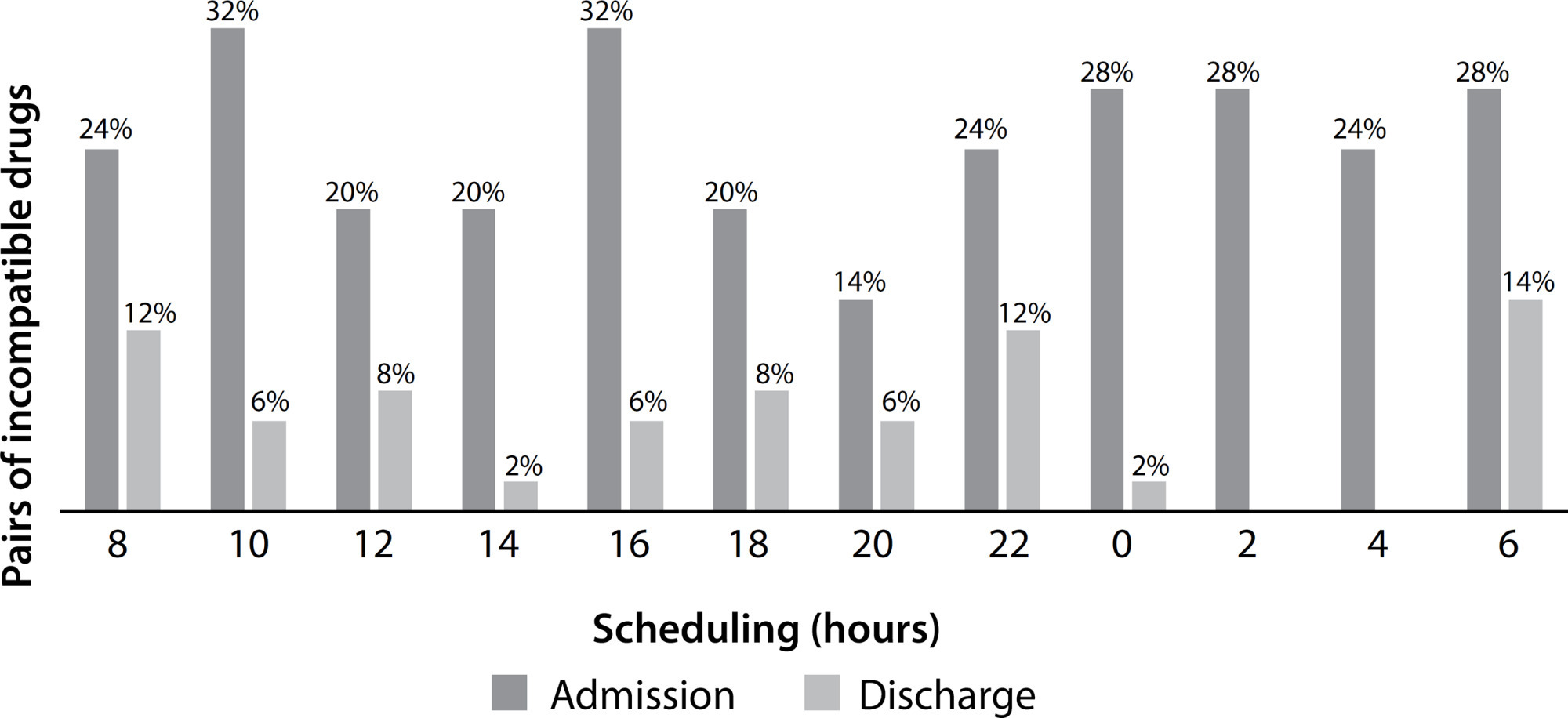
-
ORIGINAL ARTICLE05-28-2021
Prevalence and severity levels of post-radical prostatectomy incontinence: different assessment instruments
Revista Brasileira de Enfermagem. 2021;74(2):e20200692
Abstract
ORIGINAL ARTICLEPrevalence and severity levels of post-radical prostatectomy incontinence: different assessment instruments
Revista Brasileira de Enfermagem. 2021;74(2):e20200692
DOI 10.1590/0034-7167-2020-0692
Views1See moreABSTRACT
Objectives:
to analyze urinary incontinence prevalence and severity in prostatectomized men assessed by three different instruments.
Methods:
a cross-sectional study was conducted with 152 men. The pad test, pad used, and International Consultation on Incontinence Questionnaire – Short Form (self-report) were considered. Data were analyzed using Spearman’s correlation, Kappa index, considering a significance level of 0.05.
Results:
urinary incontinence prevalence was 41.4%, 46.7% and 80.3% according to pad used, pad test and self-report. Positive correlations and moderate to poor agreement were found between the instruments. As for severity, most participants had mild incontinence. The largest number of cases of mild and severe incontinence was identified by self-report.
Conclusions:
the self-report showed higher values for prevalence of mild and severe severity levels. Through the identified differences, we propose that the objective assessment (pad used and pad test) be associated with individuals’ perception (self-report) to better estimate prevalence and severity.

-
ORIGINAL ARTICLE05-28-2021
Cultural adaptation and validation of an instrument about nursing critical thinking skills
Revista Brasileira de Enfermagem. 2021;74(2):e20200720
Abstract
ORIGINAL ARTICLECultural adaptation and validation of an instrument about nursing critical thinking skills
Revista Brasileira de Enfermagem. 2021;74(2):e20200720
DOI 10.1590/0034-7167-2020-0720
Views1See moreABSTRACT
Objectives:
to validate the Nursing Critical Thinking in Clinical Practice Questionnaire regarding cultural aspects and metric properties.
Methods:
a methodological research carried out through cross-cultural adaptation, face and content validity, dimensional construct and known groups validity, test-retest reliability and internal consistency. 511 nurses from four hospitals participated in the study, of which 54 participated in retest.
Results:
the instrument validation for Brazilian Portuguese maintained equivalences, according to the original version. The dimensional validity demonstrated adjustment to the tetrafactorial structure of the original version (GFI=0.69). There were statistically significant differences in critical thinking skills between nurses with graduate degrees and who undertook training, reading articles, developing research and working in an institution with a longer time implementation of the Nursing Process. The instrument showed temporal stability (ICC 073-0.84; p<0.001) and adequate internal consistency (α=0.97).
Conclusions:
the instrument proved to be valid and reliable for the studied population.
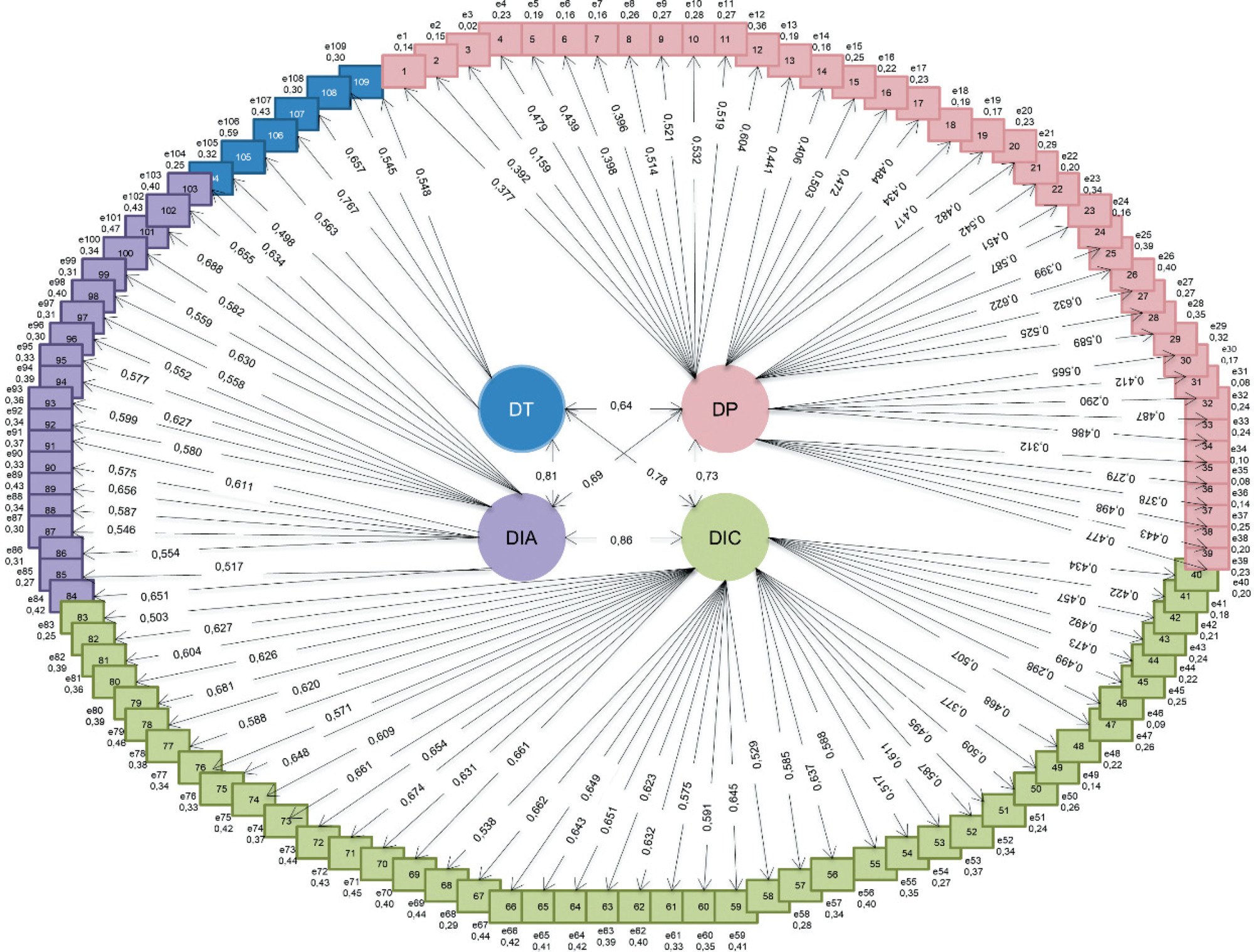
-
REVIEW05-21-2021
Evaluation strategies in active learning in higher education in health: integrative review
Revista Brasileira de Enfermagem. 2021;74(2):e20201055
Abstract
REVIEWEvaluation strategies in active learning in higher education in health: integrative review
Revista Brasileira de Enfermagem. 2021;74(2):e20201055
DOI 10.1590/0034-7167-2020-1055
Views0See moreABSTRACT
Objectives:
to analyze scientific evidence on evaluation strategies for active learning methods in health undergraduate programs.
Methods:
integrative literature review in the Medical Literature Analysis and Retrieval System Online, Latin American and Caribbean Literature in Health Sciences, Nursing Database, Scopus, Web of Science and Education Resources Information Center databases.
Results:
different evaluation strategies are used: Presentation of seminars, Self-evaluation, Evaluation of student performance in Tutotest-Lite tutoring, Peer Evaluation, Active Learning and Critical Thinking Self-evaluation Scale, Objective and Structured Clinical Exam, Portfolio, Progressive Disclosure Questions, Modified Dissertation Questions, Progression Test, Dissertation Test, Objective Test, Immediate Learning Checks, Clinical Case Resolution and Cumulative Test.
Final Considerations:
evaluation strategies in active learning are used in combination, aiming at the affective, cognitive and psychomotor development of the student. However, studies with greater power of scientific evidence would be needed.
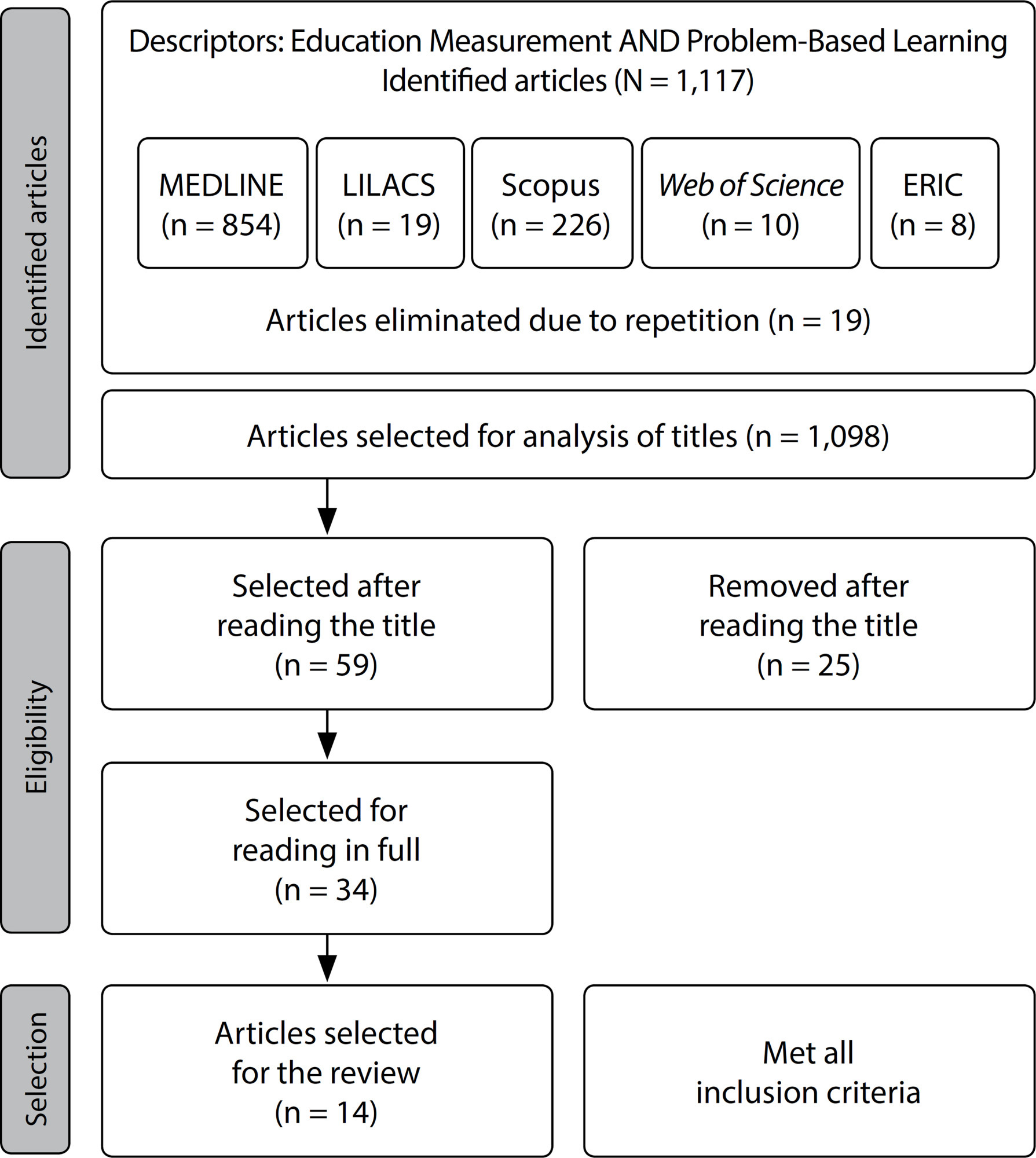
-
ERRATUM04-14-2021
ERRATUM
Revista Brasileira de Enfermagem. 2021;74(2):e2021n2e04
Abstract
ERRATUMERRATUM
Revista Brasileira de Enfermagem. 2021;74(2):e2021n2e04
DOI 10.1590/0034-7167.20217402e04
Views1Article “Obstetric analgesia in labor and its association with neonatal outcomes”, with number of DOI: , published in the journal Revista Brasileira de Enfermagem, 73(5):e20190157, in the header:Where to read:[…]See more -
ORIGINAL ARTICLE07-09-2021
Brazilian Nursing Association: fight for space in the new federal capital
Revista Brasileira de Enfermagem. 2021;74(3):e20200701
Abstract
ORIGINAL ARTICLEBrazilian Nursing Association: fight for space in the new federal capital
Revista Brasileira de Enfermagem. 2021;74(3):e20200701
DOI 10.1590/0034-7167-2020-0701
Views0See moreABSTRACT
Objectives:
to analyze the transfer process of the Brazilian Nursing Association to its new headquarters in Brasília/Federal District.
Methods:
qualitative, socio-historical, and documental study. The analysis generated the following characteristics: Associate reorganization: the transfer from the Central ABEn headquarters; and the Strategies used in the struggle for the appropriation of space.
Results:
the Brazilian Nursing Association was engaged in a struggle, which lasted nine years, for the acquisition of land in the new Federal Capital, Brasília, to ensure a prestigious place for the Association, and for nursing as well.
Final Considerations:
together with their sections, undertook efforts and implemented strategies to find a space in the new Federal Capital, allowing visibility and recognition to the nursing profession.
-
REVIEW06-07-2021
Tuberculosis/HIV coinfection from the perspective of quality of life: scope review
Revista Brasileira de Enfermagem. 2021;74(3):e20200758
Abstract
REVIEWTuberculosis/HIV coinfection from the perspective of quality of life: scope review
Revista Brasileira de Enfermagem. 2021;74(3):e20200758
DOI 10.1590/0034-7167-2020-0758
Views0See moreABSTRACT
Objectives:
to analyze evidence on the quality of life of people with tuberculosis/HIV coinfection.
Methods:
review that followed steps of the Cochrane Collaboration, with the search of publications in the bases Embase, LILACS, PubMed, and Cochrane, through the descriptors “HIV,” “Tuberculosis,” and “Quality of Life,” without a temporal cut.
Results:
the results include 15 studies, published between 2009 and 2019, with the level of evidence V, in its majority. It was observed that there is no uniformity in the instrument used. Psychological support to this group and strengthening of actions to manage both infections are necessary. This segment’s quality of life is associated with social factors and scientific production on the subject concentrated in underdeveloped countries.
Conclusions:
the articles found have a low level of scientific evidence and indicate that people who experience coinfection have a more compromised quality of life when compared to those who experience tuberculosis or HIV separately.
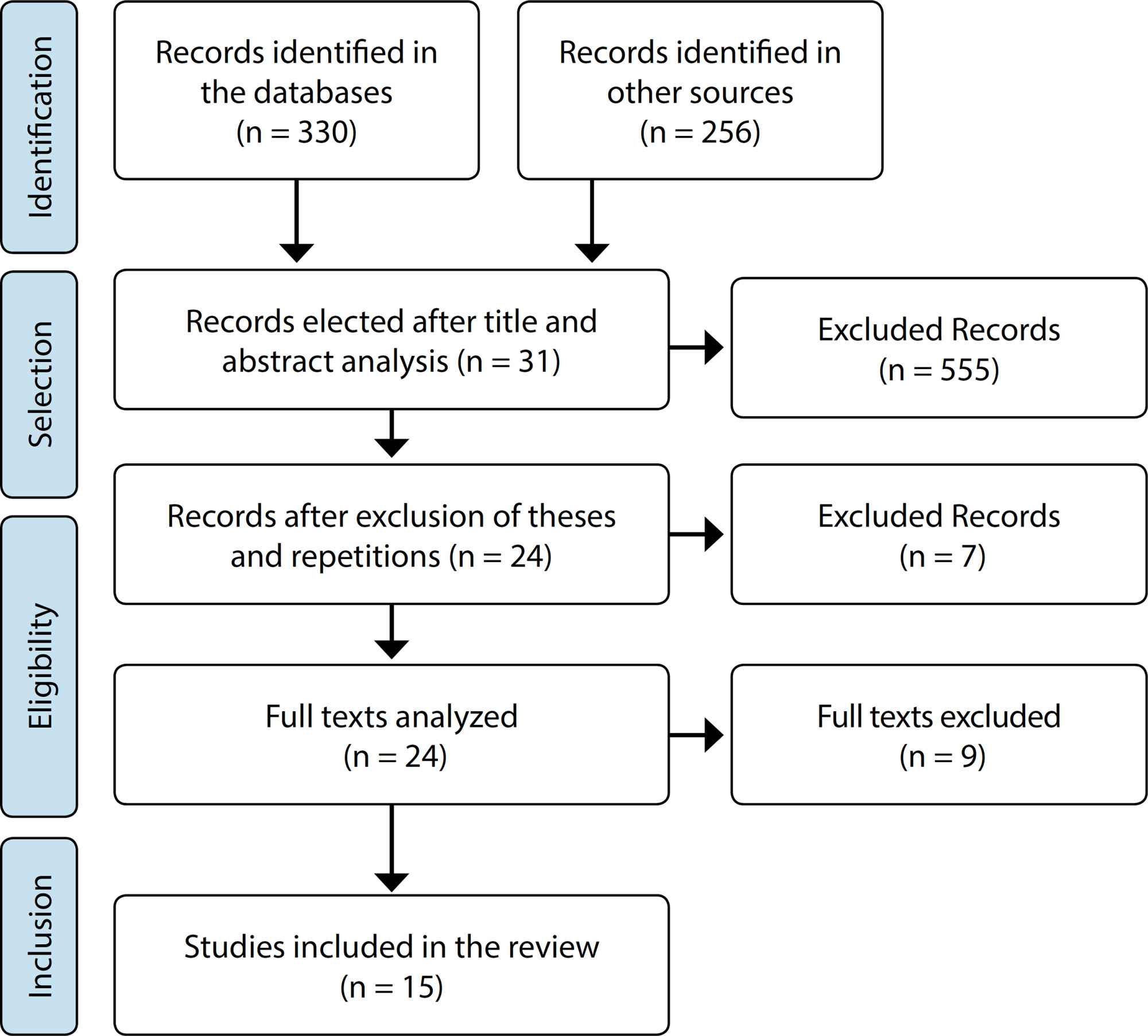
-
03-26-2021
Professional competency for elder care: perception among professors, nursing students, and nurses
Revista Brasileira de Enfermagem. 2021;74:e20200446
Abstract
Professional competency for elder care: perception among professors, nursing students, and nurses
Revista Brasileira de Enfermagem. 2021;74:e20200446
DOI 10.1590/0034-7167-2020-0446
Views0See moreABSTRACT
Objective:
to know the perception of nurses, undergraduate students, and professors about the competencies for professional nurses in elder care.
Methods:
this is a qualitative analytical study developed with six professors, four nurses, and 12 nursing students. Data were collected through semi-structured interviews and analyzed using Fiorin’s Discourse technique, with support from the MAXQDA software.
Results:
the competencies identified included knowledge of theories and general concepts of gerontology, communication, listening, leadership, teamwork, proactivity, respect, and empathy.
Final considerations:
knowing the competencies contributes to understanding the aging process and qualifying nurses for elder care.
-
ORIGINAL ARTICLE05-03-2021
Nursing care for patient in postoperatory heart surgery in the Intensive Care Unit
Revista Brasileira de Enfermagem. 2021;74(2):e20200163
Abstract
ORIGINAL ARTICLENursing care for patient in postoperatory heart surgery in the Intensive Care Unit
Revista Brasileira de Enfermagem. 2021;74(2):e20200163
DOI 10.1590/0034-7167-2020-0163
Views0See moreABSTRACT
Objective:
To investigate the critical nodes related to nursing care for patients in the postoperative period of cardiac surgery.
Methods:
Exploratory study with a qualitative approach. Data collected through semi-structured interviews with 27 members of the nursing team working in the Intensive Care Unit. Material submitted to thematic analysis.
Results:
Three categories emerged: Flaws in the professional qualification for patient care in the postoperative period of cardiac surgery; Team challenges concerning specific patient care in the postoperative period of cardiac surgery; and (dis) organization of work in the Intensive Care Unit and its impact on nursing care for patients in the postoperative period of cardiac surgery.
Final considerations:
Given the identification of the critical nodes, the professionals presented suggestions to overcome daily difficulties: investments in strategies for Permanent Education in Health; creation of tools to guide patient assistance in the postoperative of cardiac surgery; and provision of adequate human resources.
-
ORIGINAL ARTICLE10-21-2019
Social determinants of health and vulnerabilities to sexually transmitted infections in adolescents
Revista Brasileira de Enfermagem. 2019;72(6):1595-1601
Abstract
ORIGINAL ARTICLESocial determinants of health and vulnerabilities to sexually transmitted infections in adolescents
Revista Brasileira de Enfermagem. 2019;72(6):1595-1601
DOI 10.1590/0034-7167-2018-0726
Views1See moreABSTRACT
Objective:
To verify the association between social determinants of health and the vulnerability of adolescents to Sexually Transmitted Infections (STIs).
Method:
Cross-sectional study, performed with 287 students aged 11 to 17 years, in the outskirts of Fortaleza, Ceará, Brazil, from August do September 2016. Two instruments were used, one destined to social determinants of health and another to investigating the vulnerability to STIs. The magnitude of associations was expressed through odds ratio and interval of confidence, considering a 5% significance level. This research was approved by the Research Ethics Committee of the Federal University of Ceará.
Results:
212 (73.9%) adolescents were considered more vulnerable, with a score ≥ 4. The intermediate social determinant “housing (home ownership)” obtained significant association with with the vulnerability to STIs (p of 0.022; CI 1.1 to 3.3; OR 1.9).
Conclusion:
The intermediate social determinant “type of housing” influences the vulnerability to STAs.
-
REFLECTION10-19-2020
Contributions of Florence Nightingale as a social entrepreneur: from modern to contemporary nursing
Revista Brasileira de Enfermagem. 2020;73:e20200064
Abstract
REFLECTIONContributions of Florence Nightingale as a social entrepreneur: from modern to contemporary nursing
Revista Brasileira de Enfermagem. 2020;73:e20200064
DOI 10.1590/0034-7167-2020-0064
Views0See moreABSTRACT
Objective:
To reflect on the transformations of modern and contemporary nursing as well as on Florence Nightingale’s social entrepreneurship.
Method:
This is a logical-reflective exhibition, with an emphasis on the theoretical assumptions of social entrepreneurship and the legacy of Florence Nightingale, from modern to contemporary nursing, based on readings of texts extracted from electronic databases, especially periodicals, books and theses.
Results:
The logical-reflective exhibition focuses on two fundamental aspects: 1) Florence Nightingale’s legacy as a social entrepreneur; 2) The evolution of Brazilian nursing: from modernity to contemporaneity.
Final considerations:
Florence Nightingale’s legacy is undeniable with regard to the evolution of modern and contemporary nursing and transcends different areas of knowledge. In addition to being a precursor to modern nursing, it is distinguished by its visionary attitude, humanitarian social value and potential for transforming the paths and realities present in the Contemporary Era.
-
07-26-2021
Impact of clinical supervision on job satisfaction and emotional competence of nurses
Revista Brasileira de Enfermagem. 2021;74(6):e20210125
Abstract
Impact of clinical supervision on job satisfaction and emotional competence of nurses
Revista Brasileira de Enfermagem. 2021;74(6):e20210125
DOI 10.1590/0034-7167-2021-0125
Views0See moreABSTRACT
Objective:
To evaluate the impact of implementing the SafeCare clinical supervision model on nurses’ job satisfaction and emotional competence profile.
Methods:
This is a quasi-experimental study, with a sample of 28 nurses from a hospital in northern Portugal. A self-administered questionnaire was applied, used as pre and post-test, which included: sociodemographic and professional characterization; “Job Satisfaction Scale”; and “Veiga Emotional Competence Scale”. We conducted descriptive statistical analysis and the Wilcoxon Test.
Results:
A significant decrease in the nurses’ satisfaction with hierarchical superior was observed in the post-test. No significant differences were found in the nurses’ job satisfaction and emotional competence after the implementation of the SafeCare Model.
Conclusion:
The SafeCare Model needs improvement, suggesting increasing the amount of training time administered to nurses and strengthening the healthcare institution’s link to the Model.
-
ORIGINAL ARTICLE07-31-2020
Factors associated with normal and cesarean delivery in public and private maternity hospitals: a cross-sectional study
Revista Brasileira de Enfermagem. 2020;73:e20180996
Abstract
ORIGINAL ARTICLEFactors associated with normal and cesarean delivery in public and private maternity hospitals: a cross-sectional study
Revista Brasileira de Enfermagem. 2020;73:e20180996
DOI 10.1590/0034-7167-2018-0996
Views0See moreABSTRACT
Objectives:
to investigate the factors associated with the mode of delivery in pregnant women in the city of Belo Horizonte.
Methods:
cross-sectional study developed with data from the study “Being born in Belo Horizonte: survey on childbirth and birth” carried out in seven maternity hospitals in Belo Horizonte – Minas Gerais. The final sample consisted of 1088 pregnant/postpartum women. In this study, to verify the magnitude of the association between the outcome variable and its possible determinants (exposure variables) logistic regression models were constructed to estimate the Odds Ratio.
Results:
increasing age, the lack of companionship, the hospital’s private financing for performing delivery and being a first-time pregnant woman increased the chance of delivery by cesarean section.
Final Considerations:
the knowledge of factors associated with the prevalence of cesarean sections can support reflections among health professionals about this surgical procedure in certain situations, especially when there are no precise clinical indications.
-
REVIEW07-06-2020
Middle-Range Theory for the Nursing Diagnosis of Low Self-Efficacy in Health
Revista Brasileira de Enfermagem. 2020;73(5):e20190370
Abstract
REVIEWMiddle-Range Theory for the Nursing Diagnosis of Low Self-Efficacy in Health
Revista Brasileira de Enfermagem. 2020;73(5):e20190370
DOI 10.1590/0034-7167-2019-0370
Views0See moreABSTRACT
Objectives:
theoretical validation of the concept of low self-efficacy in health as a nursing diagnosis construct.
Methods:
construction of a middle-range theory for validating diagnoses, comprised of five stages: definition of the approach for building the theory; definition of the main concepts; creation of a pictorial diagram; formulation of proposals; establishment of causal relationships and evidence for clinical practice. The main concepts were identified through a literature review and the studies were taken from the LILACS, SCOPUS, CINAHL and PubMed/MEDLINE databases. The final sample was comprised of 92 articles.
Results:
eighteen etiological factors and 16 clinical indicators were identified; characterized as antecedents and manifestations for inferring a diagnosis of low self-efficacy in health.
Conclusions:
the related concepts of the new nursing diagnosis of low self-efficacy in health, to be applied in clinical nursing practice, were identified and defined.

-
ORIGINAL ARTICLE03-09-2020
Assessment of premature mortality for noncommunicable diseases
Revista Brasileira de Enfermagem. 2020;73(2):e20180440
Abstract
ORIGINAL ARTICLEAssessment of premature mortality for noncommunicable diseases
Revista Brasileira de Enfermagem. 2020;73(2):e20180440
DOI 10.1590/0034-7167-2018-0440
Views0See moreABSTRACT
Objectives:
to analyze premature mortality and Potential Years of Life Lost by noncommunicable diseases in a city in the countryside of São Paulo from 2010 to 2014.
Methods:
ecological study of temporal tendency, using secondary source. For analysis, the premature mortality coefficient and the Potential Years of Life Lost indicator were used.
Results:
males had the highest premature mortality rate due to cardiovascular disease, with 213.04 deaths per 100 thousand inhabitants, followed by neoplasms, with 188.44. In women, there was an inversion with 134.22 deaths from cancer and 110.71 deaths from cardiovascular disease. Regarding Potential Years of Life Lost, males had an average of 12.19 years lost by death and females of 13.45 years lost.
Conclusions:
the results reinforce the need to increase public health prevention and promotion policies to reduce premature deaths, especially among men.
Search
Search in:
Nuvem de Tags
Adolescente (85) Atenção Primária à Saúde (239) COVID-19 (91) Criança (91) Cuidados de Enfermagem (269) Educação em Enfermagem (151) Educação em Saúde (139) Enfermagem (930) Enfermagem Pediátrica (86) Estudantes de Enfermagem (77) Estudos de Validação (131) Família (87) Idoso (208) Promoção da Saúde (99) Qualidade de Vida (104) Saúde do Trabalhador (86) Saúde Mental (145) Saúde Pública (82) Segurança do Paciente (150) Tecnologia Educacional (100)



